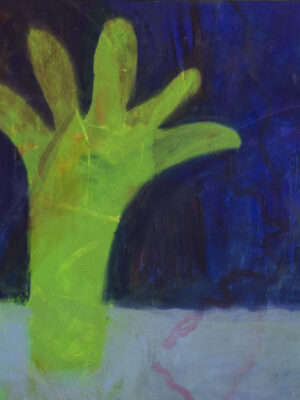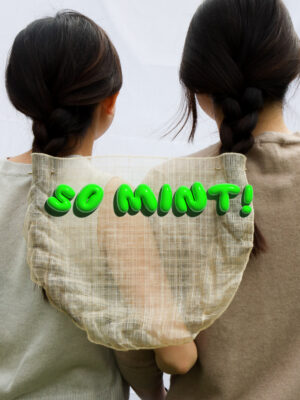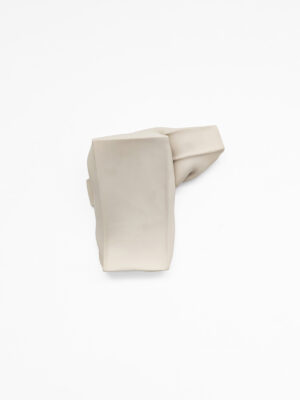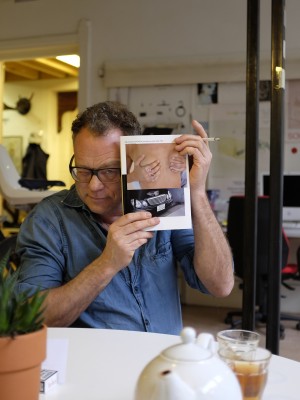
Ted Noten’s studio is a huge space in the centre of Amsterdam packed with decades of work, books, funny and weird collected items, posters, books and magazines. A hallway leads from the yellow door of the studio towards the kitchen. To the right, there are two large rooms: an office and a workroom. The ceilings are quite high, so loft-like half-floors have been constructed in every room, designated for jewellery bench work, more office spaces, or storage. The space is also filled with people – the team and the interns – as well as with many familiar pieces from past projects and collections. Amongst these items is a small postcard with an image of the Tower of Babel, a component of Ted’s exhibition one and a half years ago.
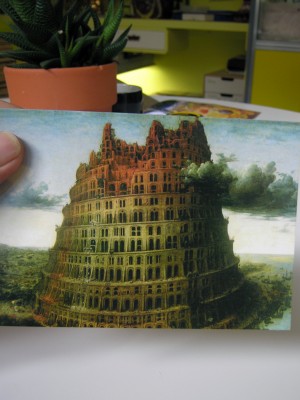
The story of the Tower of Babel and Ted Noten began in 2012 while he was preparing the show Framed by Ted Noten at the Stedelijk Museum ’s-Hertogenbosch – an exhibition as a self-portrait, through the works of others. Ted managed to amass an impressive collection of works by artists and craftsmen from various time periods and geographic locations. One piece that Ted was unable to obtain, however, was a nearly five hundred year old masterpiece by Pieter Brueghel the Elder, The Tower of Babel.
This painting is an incredibly detailed work. On a canvas of sixty by seventy-four and a half centimetres, Brueghel painted a spiralling tower that appears so enormous it looks jammed into the frame. The top of the tower floats above the clouds and its base extends itself over the dry land and the seashore. Inside the tower, more then a thousand minuscule figures of men and horses are at work, constructing, hoisting materials, and climbing ladders. The painting belongs to Rotterdam’s Boijmans Van Beuningen museum, but they decided not to part with the irreplaceable piece and declined Ted’s loan request.
Instead of the painting itself, Ted decided to display thousands of postcards with the image of the Tower of Babel on the front and Ted’s handwriting on the back; they were copies of the original postcard he first sent to the museum’s curator asking to borrow the painting. Visitors of the exhibition could pick up as many cards as they wanted to then post them if they so desired. The result was the Boijmans Van Beuningen museum receiving one and a half year’s worth of postcards, each one requesting to take the painting on loan.
I saw another connection to the Tower in December 2014 when Ted Noten showed a work called Ted’s House during Art Basel in Miami Beach (represented by Ornamentum Gallery, Hudson, NY). The work was a kind of a time loop dealing with the past, the present, and the future. It started with the past, represented by the Homage To My Grandma, a clear little acrylic trolley-bag packed with crosses (some of which belonged to Ted’s grandma) inscribed Oh, JC, JC, won’t you dance with me. Then there was Mom – an older work – a sewing machine with a water tap that leaked out faceted stones. Conversation Table, a more recent piece made in clear acrylic, meant for a hypothetical couple in discussion where, besides other paraphernalia, a big Winchester rifle was engraved on the table by the man’s side and a little gun engraved by the woman’s side.
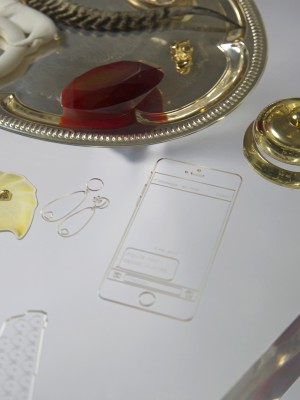
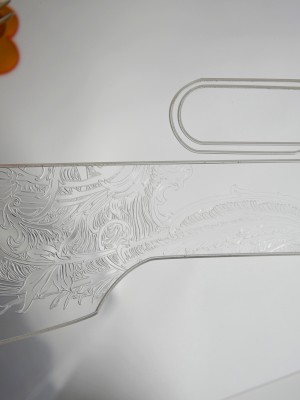
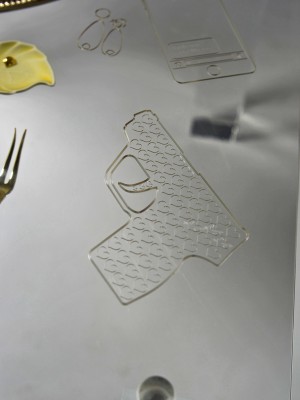
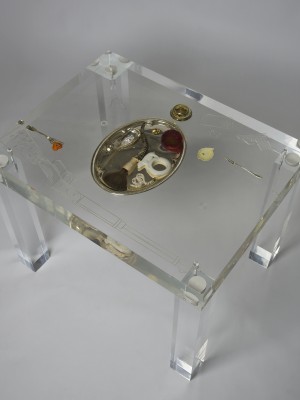


The future, according to Ted, resembles a huge bird’s-eye view photograph of a spiralling flyover highway (or skyway) in Shanghai. The intention was for the space to be open, expansive like a big window. The wide-open image of the highway is so strong it feels like the gusts of wind are blowing in your face when you look at it. It is an image of a gigantic human effort, with cars rushing up its spiral structure, just like in minuscule figures climbing up the Tower in Bruegel’s painting.
The Shanghai highway represents the future and so does the Tower Of Babel. I can just imagine Ted looking over the gigantic spiral from the height of Ted’s House; he is holding a cup of tea and wearing a necklace he has made from houseplants titled Home Is Where The Heart Is, a symbol of the present.
In Genesis, when the sons of men decided to join forces and instead of ‘replenishing the earth’ build a great city with a tower that would reach the heavens, God decided to obscure their language so they would no longer understand each other. As a result, humans couldn’t communicate, so they abandoned their ambitious project and scattered themselves around the Earth. This story is classically associated with how the Old Testament explains the origins of different languages. Another connotation of Tower Of Babel, however, is a symbol of going beyond human limitations. A tower is a human-made mountain, a construction rising toward the sky. Ancient pyramids and temples symbolise the world-old desire to reunite with the heavens and to connect with the Creator. The sounds of bells and prayers coming from the tops of religious temples around the world are directed at the heavens, amplifying the worship as they reach closer to the sky.
The tower is also a symbol of military power: a strong, resistant fortress able to protect us from the unknown. It became a symbol of society – a safeguard and a prison in one, where the architectural structure clearly marks the social divide and the hierarchies between the high and the low, the powerful and the powerless. The tower can also be associated with the ability to distance ourselves from the havoc of the world below. The quiet isolation may allow us to foresee the future and reflect in silence. Inside the tower, thought becomes directed inwards, out of touch, isolated. [2]
The story of Ted Noten and The Tower of Babel will continue this year. He plans to return to the above-mentioned museum, the Boijmans Van Beuningen, with a big solo show in June 2015. The exhibition Non Zone will coincide with the release of a new book encompassing the past ten years of Ted’s work. The exhibition will consist of three separate rooms dealing with subjects have surfaced in his recent work: the issues of authorship and originality and the point/pointlessness of an act of a human effort. In the first room, Ted plans to mock a retrospective of his own work. Instead of the actual pieces, he will be showing the exact copies of each piece he made in the past ten years 3D-printed in paper.
In the second room, there will be a pile of sand. Every, Sunday an old man (but also the director of the museum/Ted himself and other volunteers) will sit in a wooden booth to remote control a small toy truck that will pick up the sand and move it from one corner of the room to the other. And once that’s done, he will start moving it back. According to Ted, sometimes it’s necessary to do unnecessary things.
The third room however, will be of the most interest. Ted will be building a Tower of Babel made out of the contents of his entire studio, including furniture, equipment, works, office supplies, everything. Ted will be left alone inside his absolutely empty white studio. This blank canvas, this ‘burning the books’ act is where Ted wants to find himself and see what will happen. This self-inflicted isolation is an attempt for Ted to break out of his own boundaries. The stuff we surround ourselves with, the rituals we perform, the routines we create for ourselves often dictate the way we work and the way the work looks like. The stuff dictates our thinking. Building the Tower of Babel from his studio’s contents is the way for Ted to make an effort to overstep and go beyond these limitations.
A small white box will be the only thing left in his actual studio. In it, Ted will leave notes and compositions, while a CCTV camera transmits the images back to the museum to communicate his process to the audience.
Using a heavily loaded theme like the Tower of Babel, combined with a very decisive working method, signifies Ted’s balls-out approach. Many times, Ted’s work has put up a mirror to the audience. In his exemplary works like the Wanna Swap Your Ring? gun, Be Nice To A Girl Buy Her A Ring or Mercedes Benz Brooches the viewer is confronted with icons of status and sexual symbols, representing greed and the construct of value. However the Tower of Babel and Ted’s recent exhibit of his House seems to be a turn towards a rarer, more personal approach, in which he scrutinises his own methods and doubts before reflecting his questions back to the viewer. The Tower shows his loneliness and surrender to things he is not able to control. Apart from the festive nature of a grand retrospective, in which we celebrate the plethora of the artist’s achievement, the artist is also confronted with his undoing. The retrospective in some way ‘clears the cache’ of the statements the artist has produced in the past. For once, Ted is not showing us the mirror to our temptations and sins, but allows us an intimate look at his own vulnerability.
Ted’s Tower of Babel is in a way his refusal to close the book on himself. It is similar to how we can interpret salvation from the actions of God arresting the attempt to complete the tower. He does that by dispersing all the things and all the people of the tower and gives them new direction by taking away the one reliable thing that binds them. By building his own tower of Babel, Ted renders the achievements in his career as disembodied artefacts. To become lost again, while staying true to ones acquired language is what he hopes himself and the viewer to take away from this piece. Instead of burying his work in the past, he wants to clear the path to the future, and keep it wide open, like that image of the Shanghai highway.
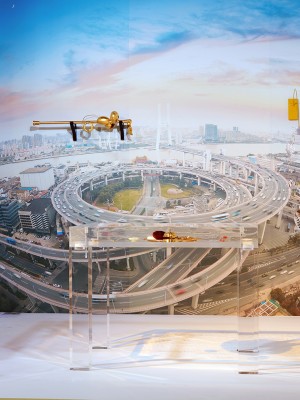
But before all his stuff is transferred to the museum and he has nothing but time to sit in the empty studio barefoot and fresh-minded, something else will happen. Ted is conspiring a new concept for an exhibition, this one taking place at contemporary jewellery gallery. At Rob Koudijs in Amsterdam, Ted will be reversing the roles of the gallerist, the artist, and the audience. He plans to infuse them with new creative meanings: a perfect answer to the thoughts expressed in the Ted Noten Manifesto first published back in 2006 and recently republished by CO. Ted keeps saying that it’s not his intention to start a revolution, but this unprecedented exhibition just might turn out to be the pebble that causes ripples in the calm and undisturbed waters of contemporary jewellery, starting irreversible and unavoidable change. [3]
1. Ted Noten: CH2=C(CH3)C(=O)OCH3 enclosures and other TNs, 0I0 Publishers (2006)
2. Archive for Research in Archetypal Symbolism, 2010. By Taschen. ‘The Book of Symbols. Reflections on archetypal Images.’ Editor-in-Chief Ami Ronnberg, Editor Kathleen Martin
3. The exhibition You And Me at Gallery Rob Koudijs was on display 18.04-23.05.2015. Current Obsession is working on the Part 2 of this article. Coming soon.
